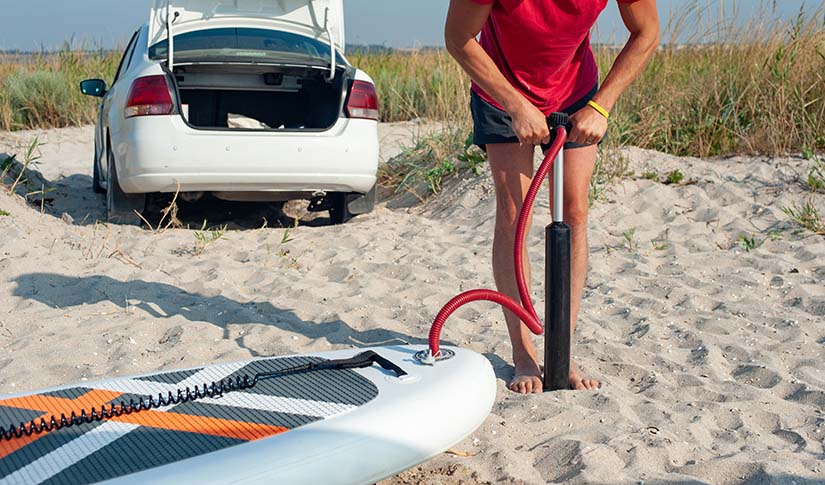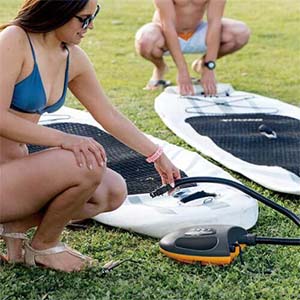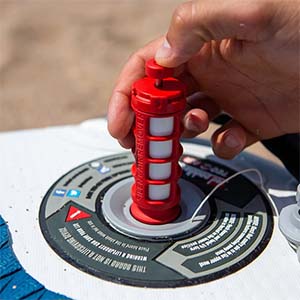Inflating your paddle board isn’t the most enjoyable part of using an iSUP. It can be a tiring and frustrating experience – not to mention it takes up some of your paddling time! However, if you learn to inflate your board properly, you can sidestep some of the problems, and avoid the headache.
Let’s take a look at the different steps of proper iSUP inflation, and you’ll you’ll be able to do it effortlessly without getting frustrated.
RELATED: What are the best electric pumps for paddle boards of 2024?
Key Takeaways
- Place your paddle board on a flat and soft surface, make sure the valve pin is up, and use a pump with a gauge to monitor the pressure.
- Electric pumps are faster and easier to use than manual pumps.
- Inflate your board to the recommended pressure, usually between 12-15 psi, to make it rigid and stable. Underinflation or overinflation can damage your paddle board.
- Deflating your board is simple and quick. Just open the valve, press the pin down, and roll the board from the nose. You can also use an electric pump with a deflate function to get all the air out.
Inflating Your SUP Board in 9 Simple Steps
Step 1: Place Your Inflatable Paddle Board on a Landing Mat
This is an important step that most people don’t consider. The surface on which you place your inflatable paddle board has to be flat and soft.
Avoid placing your SUP board on rough ground like concrete or asphalt – or any surface that may cause scratches.
If you’re using a hand pump, you can place your inflatable stand up paddle board on the grass. Sand is fine too.
With an electric pump, however, I wouldn’t recommend placing your iSUP on grass or sand. It is easy for sand particles and pieces of grass to get into your pump and cause problems. Besides, grass can leave stains on your inflatable paddle board.
I’d suggest investing in a mat, like the iRocker board mat. It provides a smooth surface free of anything that might ruin your stand up board when you’re inflating or deflating.
Step 2: Find the Valve on Your SUP
After unrolling your SUP and setting it nicely on a mat, look for the valve. For most paddle boards it is at the tail, past the deck pad, where the leash D-ring is.
Step 3: Unscrew the Valve Cap
Turn the valve cap counterclockwise to open it.
Step 4: Lift the Valve Pin
Inside the valve, you’ll see a pin. This valve pin should be in the upright position before you start to inflate your paddle board. When the pin is up, that’s the closed position and when it’s down, that’s the open position.
With the valve stem pushed down, your inflatable paddle board will leak air once you disconnect the pump hose. By the time you close the valve, the board might lose a lot of pressure and it won’t be as stiff as it should be.
So make sure the air valve pin is sticking up.
Step 5: Set Your Pump to the Desired PSI
This is for those who use electric pumps. Most of them come with an auto-shutoff function. If you set it to your desired pressure, it will stop automatically once the set number is reached.
At this point, you should also connect it to the source of power–a battery or car cigarette lighter.
ALSO READ: Can you inflate a paddleboard with an air compressor?
Step 6: Connect the Pump Hose
Attach the pump over the pin and twist it clockwise. You’ll know it is secure when you hear it lock.
Step 7: Inflate Your Inflatable SUP Board
Now it is time to start inflating. If you’re using an electric air pump, all you have to do is turn it on and wait. It will shut off automatically when done.
If you’re using a manual pump, you’ll have some work to do.
Start pumping air into your inflatable paddle board. It’s not hard but it is a mild workout. The trick is to use your entire body and not just your arms, especially when it starts getting harder.
So instead of bending your arms, keep them straight. Stretch and bend your legs instead while pumping up and down – like you’re doing a shallow squat.
The pressure gauge will register when the board is at about 7 psi.
Inflation starts to get a little too hard in the last few psi. So switch from double action to single action to make it easier.
This will depend on the design of your hand pump. There may be a lever that you have to turn or a cap that you unscrew. For instance, for the pump on the right, you’ll unscrew the small red cap to switch to single action.
Don’t forget to keep your eyes on the pump gauge and stop when the board reaches the recommended pressure.
Step 8: Disconnect the Pump
Disconnect the pump’s hose by twisting it anticlockwise. You don’t need to touch the valve.
Step 9: Screw the Valve Cap
Screw the valve cap back on.
That’s it!
ALSO READ: Are paddle board pumps universal?
How to Deflate Your Inflatable Paddle Board When You’re Done
After an amazing session of paddle boarding, you’ll want to deflate and pack up your SUP for transport and storage. Unlike inflation, deflation is a breeze and requires very little effort. And, no, you don’t need any tools–and especially not the valve wrench.
First, you should rinse off the paddle board with fresh water and let it dry completely. You don’t want to pack up a wet inflatable SUP board with all kinds of dirt on it.
Inflatable SUP boards are extremely durable, but if you don’t take good care of them they may not last long.
Once the paddle board is dry, unscrew the valve cap then press and twist the valve stem until it locks in the open (down) position. The board will start deflating.
Roll the paddle board from the nose, press as you roll to make sure you push all the air out of your SUP.
Take your rolled-up board and pack it into the SUP bag.
While deflating an iSUP is super easy, you can still use your electric pump if it has a deflate function. It will do a better job of getting all the air out of the SUP.
Note: your inflatable paddle board may let out a loud noise as air rushes out initially. If you hate the attention that it will bring you from other water users, you can buy a silent air remover. Red Paddle Co has one and it works really well.
How to Inflate Your Stand Up Paddle Board FAQs
How Hard Is It to Pump Up a SUP?
Pumping up a SUP isn’t hard at all. If you’re using an electric SUP pump, connect the pump hose, set the desired psi, and turn the pump on. Wait until the board is fully inflated. Inflation time is typically less than 10 minutes.
Using a hand pump is a bit of a workout but anybody can do it with a good pump. It can get tough towards the end but if you switch to single action it gets easier.
Most pumps come with ‘inflate paddle board’ manuals too with specific instructions based on the design of the pump.
What Pressure Should I Inflate My SUP to?
You should inflate your SUP to the recommended pressure. Every manufacturer indicates that. For most paddle boards it is usually somewhere from 12 to 15 psi.
Pay attention to the psi gauge and don’t underinflate or overinflate your SUP board.
Can You Inflate a SUP with a Compressor?
Yes, you can inflate a SUP with a compressor.
However, there are a few things you need to understand. First, the air that a regular compressor generates isn’t dry so you’ll have moisture inside your paddle board. This could lead to mold and other issues.
Another thing, the risk of overinflation is very high with a compressor. Your paddle board can easily explode.
If you choose to use a compressor to inflate your paddle board, get a SUP valve adapter designed for use with compressors. It will come with a pump gauge that allows you to monitor the inflation process and prevent overinflation.
Don’t leave the inflatable SUP board while inflating it with a compressor until it is fully inflated.
Is a Higher PSI Better for a SUP?
Yes, a higher PSI is better for a SUP. The higher the psi, the more rigid it will be. This translates to stability and better performance.
If you don’t properly inflate the SUP, it will bend in the middle when you stand on it, making it unstable and uncomfortable.
But just because a higher PSI is better doesn’t mean you should pump as much air into the SUP as you can. Overinflation is also not a good thing. It will stress the seams and the board may even explode, especially when left out in the sun.
Wrapping Up
Inflating your stand up paddle board is very easy, as you’ve seen–whether you’re using a hand pump or electric pump.
All you have to do is unroll your SUP, unscrew the valve cap and lock the valve, then attach the pump hose.
Set your desired psi if you’re using an electric paddle board pump and turn it on. If it’s a manual pump, start pumping. Remember to switch to single action if it gets too hard. Once your board is inflated, disconnect the hose and close the valve cap. It’s as simple as that!
Do you have any questions? Feel free to leave a comment below.



